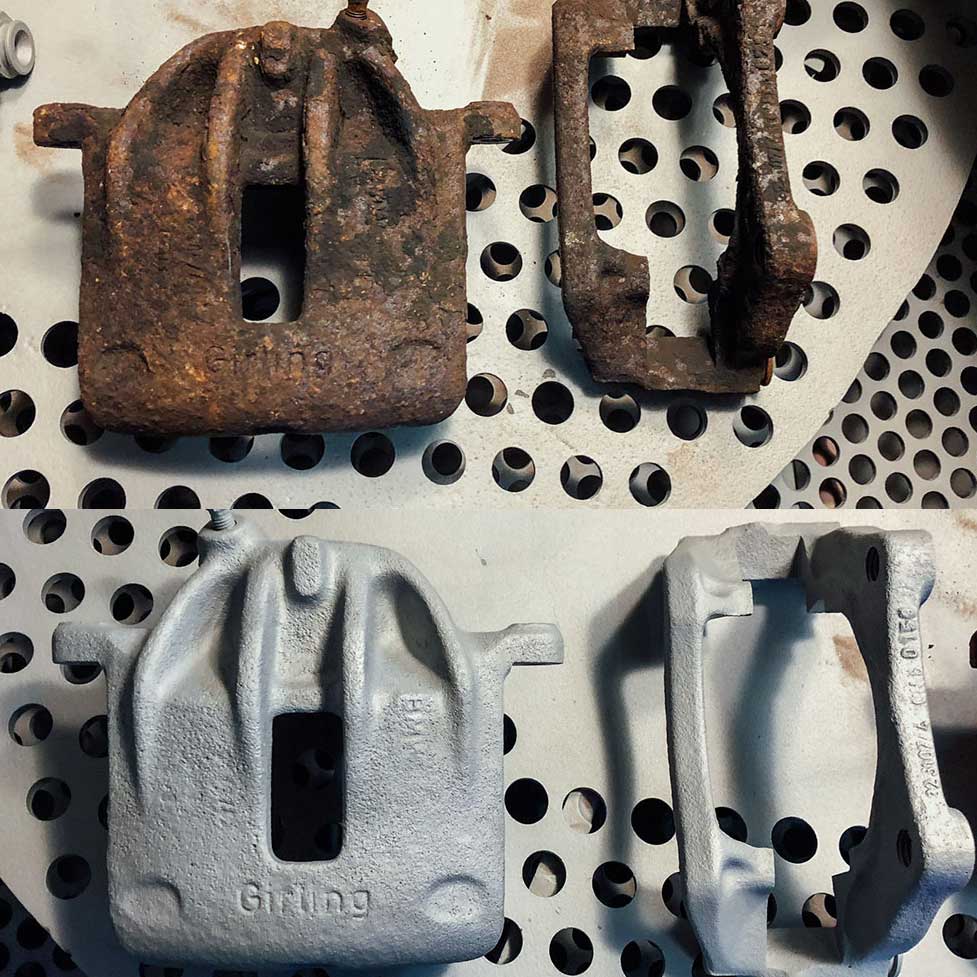Brake calipers are an important part of a vehicle’s braking system. They are designed to clamp down on the brake rotors, causing the vehicle to slow down or stop.
Purpose of Brake Calipers: The main purpose of brake calipers is to apply the necessary pressure to the brake pads, which in turn, contact the brake rotors to slow down or stop the vehicle. It’s crucial for the calipers to operate smoothly in order to ensure effective braking.
Importance of Clean Brake Calipers: Clean brake calipers are essential for optimal braking performance. Rusty brake calipers can inhibit the smooth operation of the braking system and compromise safety. Regular cleaning and maintenance can extend the lifespan of brake calipers and ensure the safety of the vehicle and its occupants.
Step-by-step Cleaning Process on About to Clean Rusty Brake Calipers
Cleaning rusty brake calipers is essential for maintaining proper brake function and preventing further corrosion.
Here’s a step-by-step guide on how to clean rusty brake calipers:
Tools and Materials Needed:
- Jack and jack stands
- Lug wrench
- Wire brush or steel wool
- Brake cleaner
- Rubber gloves
- Old rags or paper towels
- Rust converter (optional)
- High-temperature paint (optional)
- Brake caliper lubricant
Procedure:
1. Lift and Secure the Vehicle:
- Use a jack to lift the vehicle and secure it on jack stands for safety.
2. Remove the Wheel:
- Use a lug wrench to remove the wheel covering the brake caliper you want to clean.
3. Inspect the Caliper:
- Assess the extent of rust on the caliper, paying attention to areas such as the caliper body, brackets, and bolts.
4. Brush Off Loose Rust:
- Use a wire brush or steel wool to scrub away loose rust from the caliper’s surface. Pay special attention to corners, crevices, and areas around bolts.
5. Apply Brake Cleaner:
- Spray brake cleaner on the caliper to remove dirt, grease, and any remaining loose rust. Use a brush or rag to help dislodge stubborn debris.
6. Protect Surrounding Areas:
- Cover areas you don’t want to be affected by rust converter or paint with masking tape and newspaper.
7. Apply Rust Converter (Optional):
- If the rust is extensive, consider using a rust converter. Apply the rust converter following the product’s instructions. This chemical converts rust into a stable compound and provides a protective layer.
8. Wipe Off Excess Cleaner or Converter:
- Use old rags or paper towels to wipe off any excess brake cleaner or rust converter.
9. Allow to Dry:
- Allow the caliper to dry completely before moving on to the next step.
10. Apply High-Temperature Paint (Optional): – If desired, apply a high-temperature paint designed for brake calipers. This helps protect the caliper from future rust and adds a clean finish. Follow the paint manufacturer’s instructions.
11. Lubricate Moving Parts: – Apply brake caliper lubricant to sliding pins, bolts, and any moving parts. This helps prevent corrosion and ensures smooth operation.
12. Reinstall the Wheel: – Put the wheel back on and tighten the lug nuts.
13. Lower the Vehicle: – Carefully lower the vehicle from the jack stands.
14. Test the Brakes: – Before driving, gently apply the brakes to ensure they engage smoothly.
Regular inspection and cleaning of brake calipers help maintain the effectiveness of your braking system and extend the life of brake components.
If the rust is severe or if you notice any damage to the caliper, it may be advisable to consult a professional mechanic for further assessment and potential replacement.
Inspection of Rusty Brake CalipersThoroughly inspect the brake calipers, looking for areas with excessive rust buildup. Pay attention to grooves, corners, and hard-to-reach spots. Identifying the extent of rust will help determine the appropriate cleaning method. |
Cleaning the Caliper SurfaceUse a wire brush to remove loose dirt, debris, and rust from the surface of the brake caliper. Additionally, apply brake cleaner to eliminate grease and oil residue. This will ensure a clean surface for further rust removal. |
Removing Rust from CaliperTo remove stubborn rust, you can either use a rust remover solution or fine-grit sandpaper. Gently scrub the affected areas until the rust is completely removed. Take caution not to damage any other components during this process. |
Applying a Protective CoatingOnce the caliper surface is rust-free, apply a protective coating such as caliper paint or a specialized rust inhibitor. This will provide a barrier against future rust formation and enhance the overall durability of the brake calipers. |

Credit: eeuroparts.com
To sum it up, maintaining your brake calipers is crucial for the overall safety and performance of your vehicle. By following the steps outlined you can effectively clean rusty brake calipers and prevent further damage. Regular maintenance and inspection will ensure smooth braking and extend the lifespan of your brakes.
So, don’t neglect this important aspect of car maintenance and keep your brakes in top shape for a safer and enjoyable driving experience.
